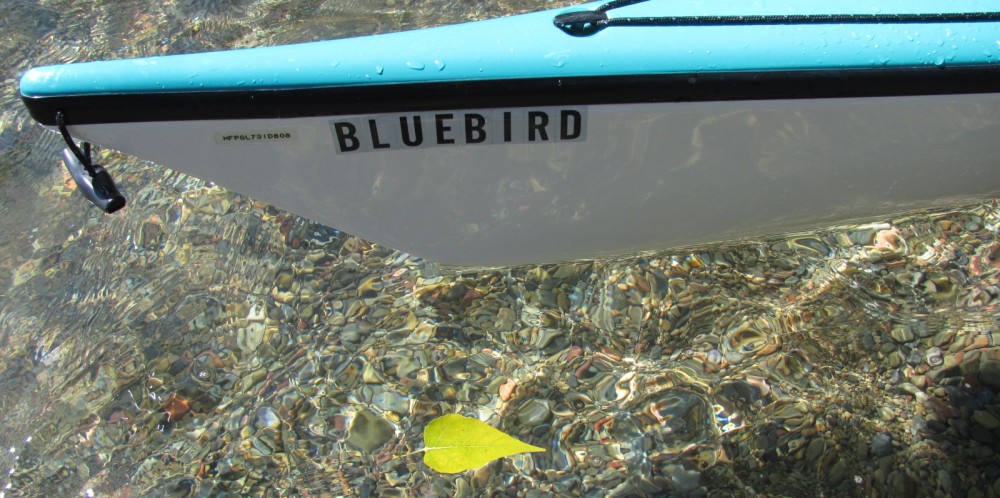This week I hope to go fishing with my friend Robin. I like fishing with him because we don’t talk very much about fish; we talk about even more important things. One afternoon, for example, I remember rolling up his driveway after a day on the river and hearing him say something like, “Consciousness is the great mystery…” Maybe on Thursday we’ll return to this topic. Paddling a kayak also points toward the same mystery.
While trying to wait patiently for weather to turn incrementally warmer, I decided to repair my kayak. In the course of 16 years on the water, Bluebird’s sensitive gel coat acquired a number of scratches and dings. At the upturned end of the stern there was a spidery crack from shipping and handling, there from the beginning, a few long scratches when I did not see a sub-surface spine of sharp rock, a more serious wound received when a wave slammed Bluebird sideways into a log. To make the repairs I went to school on YouTube, bought supplies I needed from a company in Spokane, endured a little trial and error and began to make repairs before buffing the body of the boat with a series of compounds.
In the course of this project I came to appreciate how the gel coat seems as sensitive as skin and how the boat itself is actually an instrument of perception. It feels the world through which it moves as much as skin detects changes in temperature, the slightest breeze, a tender touch, puncture or scrape. In the water the kayak feels the tap of a piece of driftwood, the cutting action of a jagged rock, the friction of gravel or sand, push or slap of wave, the buffeting of headwinds, the pressure of a tail wind. As the skin perceives the outer world, so the kayak perceives the influences and effects of the the aquatic environment. This awareness motivated me to care for my boat, to try to make it last as long as possible. A boat is a story and I want to keep it alive.

To go one step farther, as I sanded the curves to get a better bond or used progressing abrasives to level the gel coat’s creamy surface, it occurred to me that the kayak actually extends my conscious awareness into the water and weather, into the liquid body of the lake, its shorelines and depths. In short, the boat is a tactile instrument that allows me to feel more than I am capable of perceiving with my mind alone. If the tip of the shovel feels the contours of the stone in the hole where one hopes to plant a tree, so the kayak extends awareness into the topography of the lake and the vagaries of weather.
If I had any doubts about this insight I would only need to recall what it feels like to paddle at night. In the absence of light the eyes are almost useless. As never before one is forced to use the body of the boat to feel the waves, the direction of their approach, their energy and strength. At night one feels—through the skin of the kayak—what is happening in the world. To the paddler’s body the kayak transmits every signal sent by water and wind.
Alert to these things, I sense how a kayak is not just a means of transport or a way to have fun on a lake but a tool that increases one’s awareness as it extends itself into the world. It is the tactile equivalent of binoculars used to focus on a vireo reaching for the last berry in a mountain ash, or a telescope turned toward a star. No wonder it seems worthy of attention and repair. Through its sensitive hull I want to keep in touch with the watery world.

Gary, thank you for your “philosophical turn” about your kayak. My calling it a kayak or a boat doesn’t do it justice at all, for as you have written here “I came to appreciate how the gel coat seems as sensitive as skin and how the boat itself is actually an instrument of perception. It feels the world through which it moves as much as skin detects changes in temperature, the slightest breeze, a tender touch, puncture or scrape.” How lyrical and true. One of my own kayaks, affectionately called Red Boat, was a 9 foot play boat, keelless and designed for white water. However, I used her exclusively on a small lake in my backyard due to her being very lightweight and easy to put in from our dock. Red Boat was exquisitely attuned in the way you describe. The mere act of slightly turning only my head to look to the right or left caused Red Boat to follow my lead, without a single stroke of paddle to set the course. I do hope that when you and Robin get around to fishing that your musings about consciousness resume!
Babsje, thank you for telling me about Red Boat and its responsiveness to your slightest movement. Boats can come to seem like dance partners where the slightest change in pressure leads in a new direction.